
Service and Appearance Care
The 1998 Chevrolet Corvette Intelligent Owner’s Manual ©
NEW! Virtual Directions - Changing the Air Filter
Still Not Finding what you need for your Corvette? Try the Custom Corvette Search Engine for the C5. This search engine is especially designed by the Intelligent Owner’s Manual © and Google.

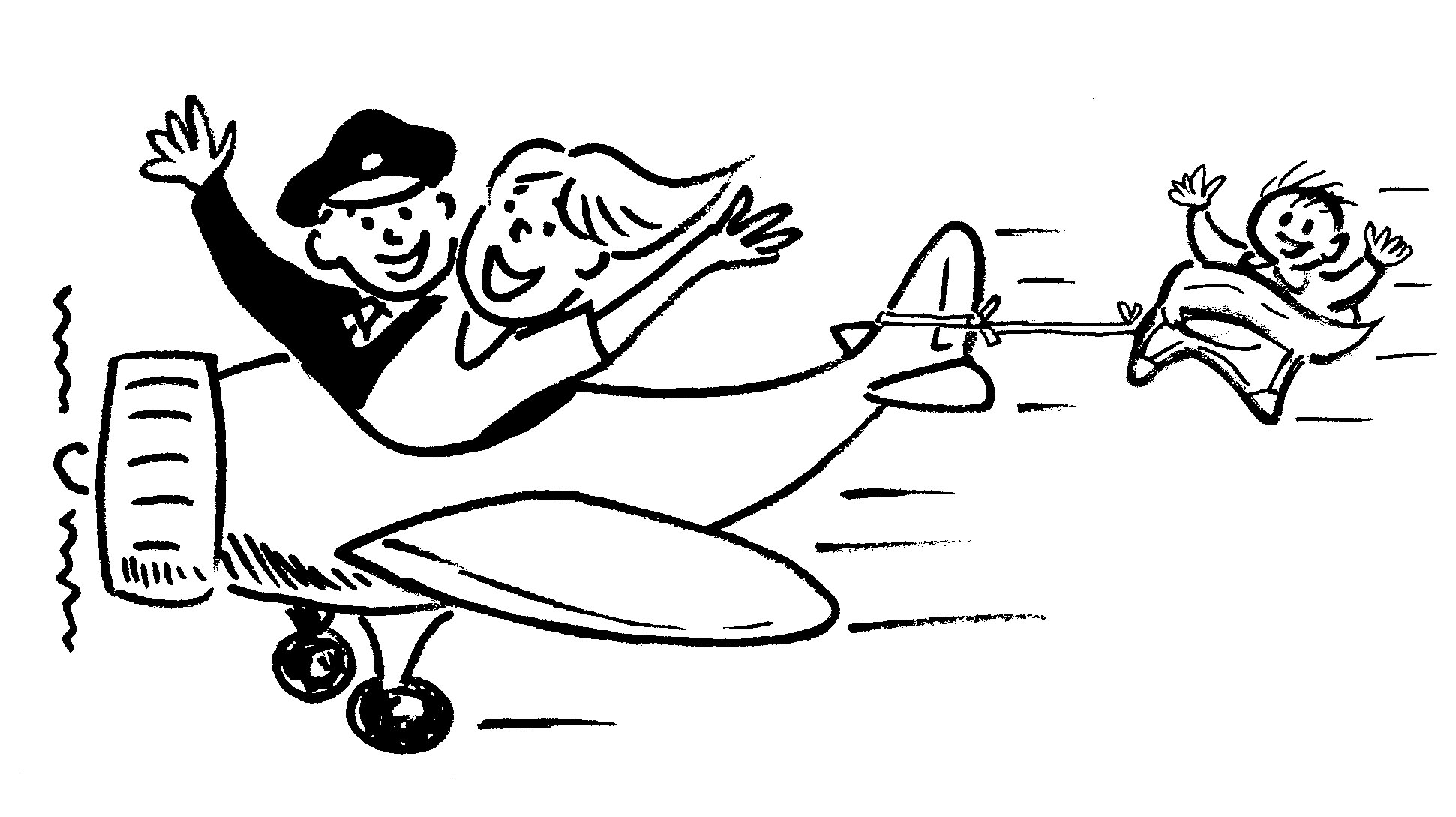 |
Free Food and Free Attractions Around the World |
Go To |
B / E / F / H / M / P / R / S / T / U / W
Here you will find information about the care of your vehicle. This section begins with service and fuel information, and then it shows how to check important fluid and lubricant levels. There is also technical information about your vehicle, and a part devoted to its appearance care.
Appearance Care Materials Chart
Vehicle Identification Number (VIN)
Service Parts Identification Label
Electrical System
Replacement Bulbs
Capacities and Specifications
CAUTION:
You can be injured and your vehicle could be damaged if you try to do service work on a vehicle without knowing enough about it.
Be sure you have sufficient knowledge, experience, the proper replacement parts and tools before you attempt any vehicle maintenance task.
Be sure to use the proper nuts, bolts and other fasteners. "English" and "metric" fasteners can be easily confused. If you use the wrong fasteners, parts can later break or fall off. You could be hurt.
Adding Equipment to the Outside of Your Vehicle
Things you might add to the outside of your vehicle can affect the airflow around it. This may cause wind noise and affect windshield washer performance. Check with your dealer before adding equipment to the outside of your vehicle.
Use premium unleaded gasoline rated at 91 octane or higher for best performance. You may use middle grade or regular unleaded gasolines, but your vehicle may not accelerate as well.
At a minimum, the gasoline you use should meet specifications ASTM D48 14 in the United States and CGSB 3.5-M93 in Canada. Improved gasoline specifications have been developed by the American Automobile Manufacturers Association (AAMA) for better vehicle performance and engine protection. Gasolines meeting the AAMA specification could provide improved driveability and emission control system protection compared to other gasolines.
Be sure the posted octane for premium is at least 91 (at least 89 for middle grade and 87 for regular). If the octane is less than 87, you may get a heavy knocking noise when you drive. If it’s bad enough, it can damage your engine.
If you’re using fuel rated at the recommended octane or higher and you hear heavy knocking, your engine needs service. But don’t worry if you hear a little pinging noise when you’re accelerating or driving up a hill. That’s normal, and you don’t have to buy a higher octane fuel to get rid of pinging. It’s the heavy, constant knock that means you have a problem.
If your vehicle is certified to meet California Emission Standards (indicated on the underhood emission control label), it is designed to operate on fuels that meet California specifications. If such fuels are not available in states adopting California emissions standards, your vehicle will operate satisfactorily on fuels meeting federal specifications, but emission control system performance may be affected. The malfunction indicator lamp on your instrument panel may turn on and/or your vehicle may fail a smog-check test. If this occurs, return to your authorized Corvette dealer for diagnosis to determine the cause of failure. In the event it is determined that the cause of the condition is the type of fuels used, repairs may not be covered by your warranty.
Some gasolines that are not reformulated for low emissions contain an octane-enhancing additive called methylcyclopentadienyl manganese tricarbonyl (MMT); ask your service station operator whether or not his fuel contains MMT. General Motors does not recommend the use of such gasolines. If fuels containing MMT are used, spark plug life may be reduced and your emission control system performance may be affected. The malfunction indicator lamp on your instrument panel may turn on. If this occurs, return to your authorized Corvette dealer for service.
To provide cleaner air, all gasolines in the United States are now required to contain additives that will help prevent deposits from forming in your engine and fuel system, allowing your emission control system to function properly. Therefore, you should not have to add anything to the fuel. In addition, gasolines containing oxygenates, such as ethers and ethanol, and reformulated gasolines may be available in your area to help clean the air. General Motors recommends that you use these gasolines if they comply with the specifications described earlier.
NOTICE:
Your vehicle was not designed for fuel that contains methanol. Don’t use it. It can corrode metal parts in your fuel system and also damage plastic and rubber parts. That damage wouldn’t be covered under your warranty.
If you plan on driving in another country outside the United States or Canada, the proper fuel may be hard to find. Never use leaded gasoline or any other fuel not recommended in the previous text on fuel. Costly repairs caused by use of improper fuel wouldn’t be covered by your warranty. To check on fuel availability, ask an auto club, or contact a major oil company that does business in the country where you’ll be driving.
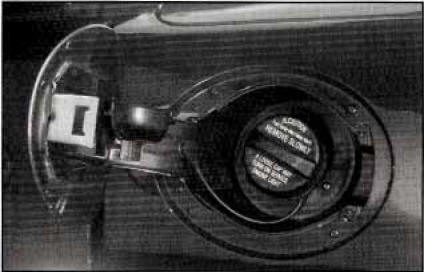
The fuel filler door is on the driver’s side of the vehicle. The fuel cap is attached by a tether for your convenience.
CAUTION:
Gasoline vapor is highly flammable. It burns violently, and that can cause very bad injuries. Don’t smoke if you’re near gasoline or refueling your vehicle. Keep sparks, flames and smoking materials away from gasoline.
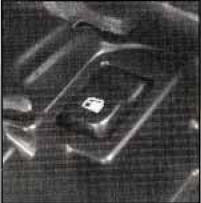
The fuel filler door release is the black button at the front of the center console storage compartment.
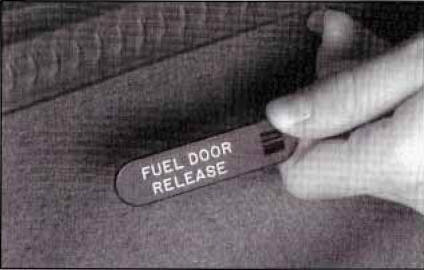
If your fuel filler door release won’t operate, there is a manual release tab. The tab is located against the upper trim on the driver’s side in the rear compartment.
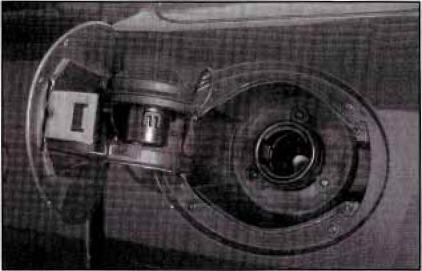
While refueling, place the cap in the holder on the fuel filler door to prevent damage to your vehicle’s finish. To remove the cap, turn it slowly to the left (counterclockwise). The cap has a spring in it; if you let go of the cap too soon, it will spring back to the right.
When you put the cap back on, turn it to the right (clockwise) until you hear a clicking sound. Make sure you fully install the cap.
CAUTION:
If you
get gasoline on yourself and then something ignites it, you could be badly burned. Gasoline can spray out on you if you open the fuel filler cap too quickly. This spray can happen if your tank is nearly full, and is more likely in hot weather. Open the fuel filler cap slowly and wait for any "hiss" noise to stop. Then unscrew the cap all the way.Be careful not to spill gasoline. Clean gasoline from painted surfaces as soon as possible. See
"Cleaning the Outside of Your Vehicle"NOTICE:
If you need a new cap, be sure to get the right type. Your dealer can get one for you. If you get the wrong type, it may not fit or have proper venting, and your fuel tank and emissions system might be damaged.
Filling a Portable Fuel Container
Caution
Never fill a portable fuel container while it is in your vehicle. Static electricity discharge from the container can ignite the gasoline vapor. You can be badly burned and your vehicle damaged if this occurs. To help avoid injury to you and others:
Dispense gasoline only into approved containers.
Do not fill a container while it is inside a vehicle, in a vehicle’s trunk, pickup bed oron any surface other than the ground.
Bring the Fill Nozzle in contact with the inside of the fill opening before operating the nozzle. Contact should be maintained until the filling is complete.
Don’t smoke while pumping gasoline.
Checking Things Under the Hood
Caution
An electric fan under the hood can start up and injure you even when the engine is not running. Keep hands, clothinga nd tools away from any underhood electric fan.
Caution
Things that burn can start a fire. These include liquids like
gasoline, oil, coolant, brake fluid, windshield washer and other fluids, and
plastic or rubber. You or others could be burned. Be careful not to drop or
spill
things that will burn onto a hot engine.
NOTICE:
In order to avoid possible contact of the hood to the headlamp doors, care should be taken in raising the hood with the headlamps up, or shut off the lamps prior to opening the hood.
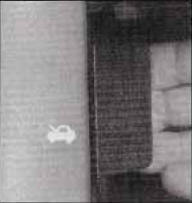
To open the hood, first pull the handle inside the vehicle.
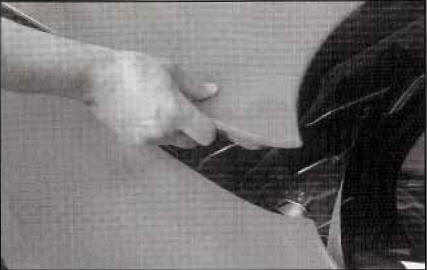
Then go to the side of the vehicle and pull up on the rear edge of the hood, near the windshield.
You'll see the following when you open the hood:
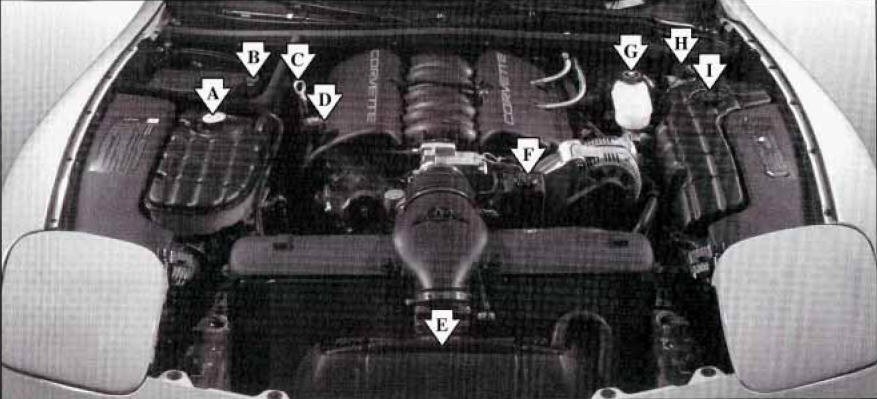
A. Coolant Surge Tank and Pressure Cap
B. Battery
C. Engine Oil Dipstick
D. Engine Oil Fill Cap
E. Air Cleaner
E Power Steering Fluid Reservoir
G. Brake Fluid Reservoir
H. Hydraulic Clutch Fluid Reservoir (If Equipped)
I. Windshield Washer Fluid Reservoir
Before closing the hood, be sure all the filler caps are on properly. Then, just pull the hood down and close it firmly.
If the LOW OIL LEVEL message on the Driver Information Center comes on, it means you need to check your engine oil level right away. For more information, see "Driver Information Center" . You should check your engine oil level regularly; this is an added reminder.
It’s a good idea to check your engine oil level every time you get fuel. In order to get an accurate reading, the oil must be warm and the vehicle must be on level ground.
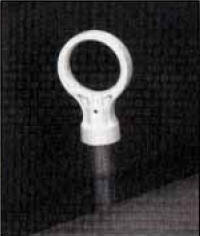
The engine oil dipstick is next to the coolant surge tank. The dipstick handle is a round, yellow loop. Turn off the engine and give the oil a few minutes to drain back into the oil pan. If you don’t, the oil dipstick might not show the actual level.
Pull out the dipstick and clean it with a paper towel or a cloth, then push it back in all the way. Remove it again, keeping the tip down.
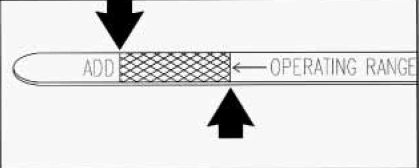
If the oil is at or below the ADD mark, you’ll need to add at least one quart of oil. But you must use the right kind. This part explains what kind of oil to use. For crankcase capacity, see
"Capacities and Specifications" in the Index.NOTICE:
Don’t add too much oil. If your engine has so much oil that the oil level gets above the upper mark that shows the proper operating range, your engine could be damaged.
The engine oil fill cap is on top of the right valve rocker arm cover.
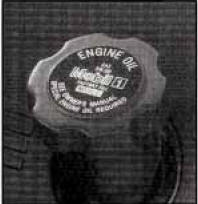
Be sure to fill it enough to put the level somewhere in the proper operating range. Push the dipstick all the way back in when you’re through.
What Kind of Engine Oil to Use
Look for two things:
1) GM4718M
The Corvette engine requires a special oil meeting GM Standard GM4718M. Oils meeting this Standard may be identified as synthetic. However, not all synthetic oils will meet this GM Standard. You should look for and use only an oil that meets GM Standard GM4718M.
NOTICE:
If you use oils that don’t have the GM4718M Standard designation, you can cause engine damage not covered by your warranty.
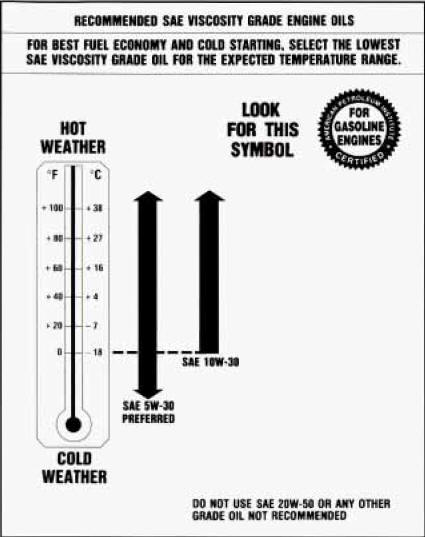
2) SAE 5W-30
As shown in the viscosity chart, SAE
5W-30 is best for your vehicle. However, you can use SAE 1OW-30 if it’s going to be 0°F (-18°C) or above.’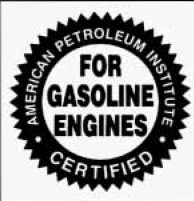
These numbers on an oil container show its viscosity, or thickness. Do not use other viscosity oils such as SAE 2OW-50.
Oils meeting these requirements should also have the "Starburst" symbol on the container.
This symbol indicates that the oil has been certified by the American Petroleum Institute (API). Do not use any oil which does not carry this Starburst symbol.
You should look for this on the oil container, and use only those oils that are identified as meeting GM Standard 4718M and have the Starburst symbol on the front of the oil container.
Your Corvette engine is filled at the factory with a Mobil l@ synthetic oil, which meets all requirements for your vehicle.
Substitute Engine Oil: When adding oil to maintain engine oil level, oil meeting GM Standard GM4718M may not be available. You can add substitute oil designated SAE 5W-30 with the "Starburst" symbol at all temperatures. If temperatures are above 0 O F (- 18 Degrees C), you may substitute SAE low-30 with the "Starburst" symbol. Substitute oil not meeting GM Standard GM4718M should not be used for an oil change.
Don’t add anything to your oil. Your dealer is ready to advise if you think something should be added.
Your Corvette has an Engine Oil Life Monitor. This feature will let you know when to change your oil and filter -- usually between 3,000 miles ( 5000 km) and 10,000 miles (16 000 km) since your last oil change.
Under severe conditions, the indicator may come on before 3,000 miles ( 5 000 km). Never drive your vehicle more than 10,000 miles (16 000
km) or 12 months (whichever occurs first) without an oil change. Use engine oil meeting the GM Standard GM4718M.The system won’t detect dust in the oil. So, if you drive in a dusty area, be sure to change your oil every 3,000 miles (5 000 lun) or sooner if the CHANGE OIL light comes on. Remember to reset the Engine Oil Life Monitor when the oil has been changed. For more .information, see
"Engine Oil Life Monitor".There is a special procedure for changing engine oil, contact your dealer for additional information or the procedure can be found in a Corvette Service Manual. To purchase a service manual, see
"Service and Owner Publications"How to Reset the Engine Oil Life Monitor
Press RESET to acknowledge the CHANGE OIL SOON warning. The oil page will then show a message such as OIL LIFE 0%. To reset the monitor, press and hold RESET for two seconds. You will then receive a message such as OIL LIFE 99%.
Did you know that used engine oil contains certain elements that may be unhealthy for your skin and could even cause cancer? Don’t let used oil stay on your skin for very long. Clean your skin and nails with soap and water, or a good hand cleaner. Wash or throw away clothing or rags containing used engine oil. (See the manufacturer’s warnings about the use and disposal of oil products.)
Used oil can be a real threat to the environment. If you change your own oil, be sure to drain all free-flowing oil from the filter before disposal. Don’t ever dispose of oil by putting it in the trash, pouring it on the ground, into sewers, or into streams or bodies of water. Instead, recycle it by taking it to a place that collects used oil. If you have a problem properly disposing of your used oil, ask your dealer, a service station or a local recycling center for help.
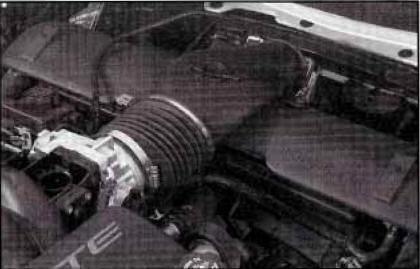
Refer to the Maintenance Schedule to determine when to replace the air filter. See
"Scheduled Maintenance Services" . To get a high performance air filter at an unbeatable price, click here.Caution Operating the engine with the air cleaner off can cause you or others to be burned. The air cleaner not only cleans the air, it stops flame if the engine backfires. If it isn’t there, and the engine backfires, you could be burned. Don’t drive with it off, and be careful working on the engine with the air cleaner off.
NOTICE:
If the air cleaner is off, a backfire can cause a damaging engine fire. And, dirt can easily get into your engine, which will damage it. Always have the air cleaner in place when you’re driving.
To remove the air filter:
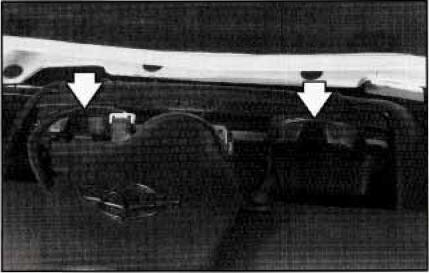
1. Pull up on the clips on each side to release the assembly.
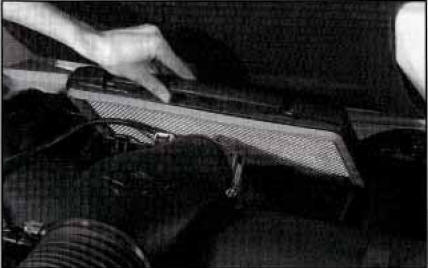
2. Pull the assembly out.
3. Replace the filter.
4. Push the assembly back into place.
5. Fasten the clips.
Replacing a clogged air filter can improve your car's gas mileage by as much as 10 percent. To learn how to save up to 40% on the gas you use, Click Here.
Automatic Transmission
Fluid
How to Check
Because this operation is difficult, you may choose to have this done at
your dealer service department. It is not necessary to check the transmission
fluid level. A transmission fluid leak is the only reason for fluid loss. If a
leak occurs, take the vehicle to your dealer service department and have it
repaired as soon as possible. There is a special procedure for checking and
changing the transmission fluid. Contact your dealer for additional information
or the procedure can be found in a Corvette Service Manual. To purchase a
service manual, see “Service and Owner
Publications’’ in the Index.
NOTICE:
We recommend that only fluid labeled DEXRON@-111 be used, because fluid with
that label is made specially for your automatic transmission. Damage causedb y
fluid other than DEXRON@-111is not covered by your new vehicle warranty.
Change both the fluid and filter every 50,000 miles (80 000 km) if the vehicle is mainly driven under one of these conditions:
In heavy city traffic where the outside temperature regularly reaches 90 OF (32 O C) or higher.
In hilly or mountainous terrain.
High performance operation.
If you do not use your vehicle under one of these conditions. Change the fluid
and filter every
100,000 miles (166 000 km). See “Scheduled
Maintenance Services” for
the proper service intervals for the transmission fluid and filter.
A good time to have it checked is when the engine oil is changed. However, the fluid in your manual transmission doesn’t require changing.
Because this operation can be difficult, you may choose to have't his done at
your Chevrolet dealership Service Department.
If you do it yourself, be sure to follow all the instructions here, or you could
get a false reading.
NOTICE:
Too much or too little fluid can damage your transmission. Too much can mean
that some of the fluid could come out and fall on hot exhaust system parts,
starting a fire. Be sure to get an accurate reading if you check your
transmission fluid.
Check the fluid level only when your engine is off, the vehicle is parked on a
level place and the transmission is cool enough for you to rest your fingers on
the transmission case.
Then, follow these steps:
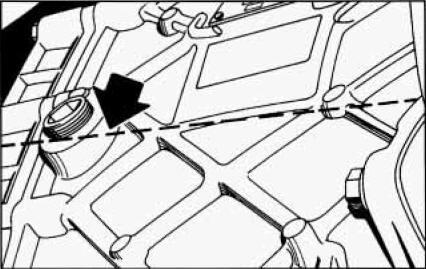
1. Remove the filler plug.
2. Check that the lubricant level is up to the bottom of the filler plug hole.
3. If the fluid level is good, install the plug and be sure it is fully seated.
If the fluid level is low, add more fluid as described in the next steps.
How to Add Fluid
Here’s how to add fluid. Refer to the Maintenance Schedule to determine what
kind of fluid to use. See “Recommended
Fluids and Lubricants” in the Index.
1. Remove the filler plug.
2. Add fluid at the filler plug hole. Add only enough fluid to bring the fluid
level up to the bottom of the filler plug hole.
3. Install the filler plug. Be sure the plug is fully seated.
4. Tighten the plug to 20 1b.-ft. (27 N-m).
Hydraulic Clutch
The clutch linkage in your vehicle is self-adjusting. The clutch master cylinder
reservoir is filled with hydraulic clutch fluid.
It is not necessary to regularly check clutch fluid unless you suspect there is a leak in the system. Adding fluid won’t correct a leak.
A fluid loss in this system could indicate a problem. Have the system inspected and repaired.
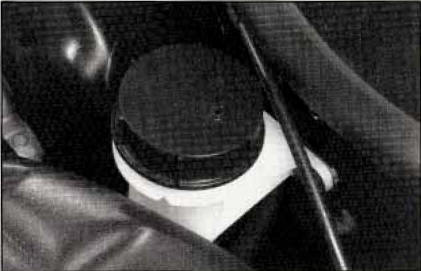
Refer to the Maintenance Schedule to determine how often you should check the
fluid level in your clutch master cylinder reservoir and for the proper fluid
.See “Owner Checks and Services”
and “Recommended Fluids and Lubricants”
in the Index.
The clutch master cylinder is on the driver’s side of the engine compartment,
near the fender. To check the fluid, remove the cap and rubber seal. Fluid
should be added if the fluid level is below the step on the inside of the
reservoir. There are additional instructions on the reservoir cap. Replace the
rubber seal and cap.
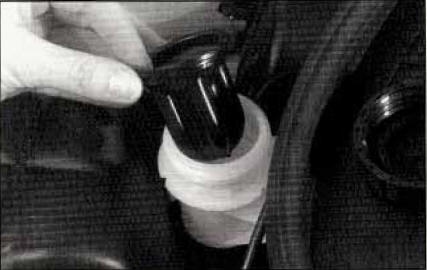
When to Check Lubricant
Refer to the Maintenance Schedule to determine how often to check the lubricant.
See “Periodic Maintenance Inspections”
in the Index.

If the level is below the bottom of the filler plug hole, you’ll need to add
some lubricant. Add enough lubricant to raise the level to the bottom of the
filler plug hole.
To add lubricant when the level is low, use Axle Lubricant (GM Part No.
12345977) or SAE 8OW-90 GL-5 gear lubricant. To completely refill after
draining, add 4 ounces (1 18m l) of Limited-Slip Differential Lubricant Additive
(GM Part No. 1052358). Then fill to the bottom of the filler plug hole with Axle
Lubricant (GM Part No. 12345977) or SAE 8OW-90 GL-5
gear lubricant.
The cooling s stem in your vehicle is filled with DEX-COOL engine coolant. This
coolant is designed to remain in your vehicle for 5 years or 150,000 miles (240
000 km) whichever occurs first, if you add only DEX-COOL’ extended life coolant.
The following explains your cooling system and how to add coolant when it is
low. If you have a problem with engine overheating, see “Engine
Overheating” in the Index.
A 50/50 mixture of water and DEX-COOL@
coolant will:
Give freezing protection down to -34°F (-37°C).
Give boiling protection up to 265 “F (129” C).
Protect against rust and corrosion.
Help keep the proper engine temperature.
Let the warning lights and gauges work as they should.
NOTICE:
When adding coolant, it is important that you use only DEX-COOL@ (silicate-free) coolant. If coolant other than DEX-COOL is added to the system, premature engine, heater core or radiator corrosion may result. In addition, the engine coolant will require change sooner- - at 30,000 miles (50 000 km) or 24 months, whichever occurs first. Damage caused tbhye use of coolant other than DEX-COOL@ is not covered by your new vehicle warranty.
Use a mixture of one-half clean water (preferably distilled) and one-half DEX-COOL@ coolant which won’t damage aluminum parts. If you use this mixture, you don’t need to add anything else.
CAUTION:
Adding only plain water to your cooling system can be
dangerous. Plain water, or some other liquid like alcohol can boil before the
proper coolant mixture will. Your vehicle’s coolant warning system is set for
the proper coolant mixture. With plain water or the wrong mixture, your engine
could get too hot but you wouldn’t get the overheat warning. Your engine could
catch fire and you or others could be burned. Use a 50/50 mixture of clean water
and DEX-COOL@ coolant.
NOTICE:
If you use an improper coolant mixture, your engine could overheat and be badly
damaged. The repair cost wouldn’t be covered by your warranty. Too much water in
the mixture can freeze and crack the engine, radiator, heater core and other
parts.
If you have to add coolant more than four times a year, have your dealer check
your cooling system.
NOTICE:
If you use the proper coolant, you don’t have to add extra inhibitors or
additives which claim to improve the system. These can be harmful.
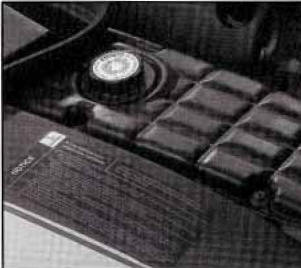
The coolant surge tank is in the engine compartment behind the headlamp.
CAUTION
Turning the surge tank pressure cap when the engine and radiator are hot can allow steam and i scalding liquids to blow out and burn you badly. Never turn the surge tank pressure cap -- even a little -- when the engine and radiator are hot.
When your engine is cold, the coolant level should be at the FULL COLD mark. Don’t overfill the surge tank. Too much coolant can result in an over flow when the fluid is hot.
If the LOW COOLANT message comes on, it means you’re low on engine coolant.
Adding Coolant
If you need more coolant, add the proper DEX-COOL@ coolant mixture at the surge
tank, but only when the
engine is cool.
CAUTION:
You can be burned if you spill coolant on hot engine parts. Coolant contains ethylene glycol, and it will burn if the engine parts are hot enough. Don’t spill coolant on a hot engine.
When replacing the pressure cap, Make sure it is tight.
NOTICE:
The surge tank pressure caips a 15 psi (105 kPa) pressure-type cap and must be
tightly installed to prevent coolant loss and possible engine damage from
overheating. When you replace the surge tank pressure cap, a GM cap is
recommended.
Thermostat
Engine coolant temperature is controlled by a thermostat in the engine coolant
system. The thermostat stops the flow of coolant through the radiator until the
coolant reaches a pre-set temperature. When you replace the thermostat, a GM
thermostat is recommended.
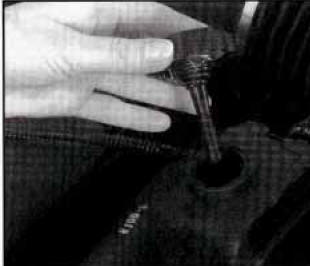
When to Check Power Steering Fluid It is not necessary to regularly check power
steering fluid unless you suspect there is a leak in the system or you hear an
unusual noise. A fluid loss in this system could indicate a problem. Have the
system inspected and repaired.
How To Check Power Steering Fluid
When the engine compartment is cool, wipe the cap and the top of the reservoir
clean, then unscrew the cap and wipe the dipstick with ac lean rag. Replace the
cap and completely tighten it. Then remove the cap again and look at the fluid
level on the dipstick.
The level should be at the FULL COLD mark. If necessary, add only enough fluid
to bring the level up to the mark.
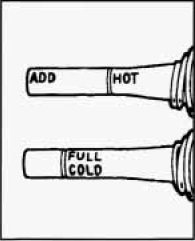
When the engine compartment is hot, the level should be at the HOT mark.
When the engine compartment is cool, the
level should be at the FULL COLD mark.
To determine what kind of fluid to use, see “Recommended Fluids and Lubricants” in the Index. Always use the proper fluid. Failure to use the proper fluid can cause leaks and damage hoses and seals.
When you need windshield washer fluid, be sure to read the manufacturer’s instructions before use. If you will be operating your vehicle in an area where the temperature may fall below freezing, use a fluid that has sufficient protection against freezing.
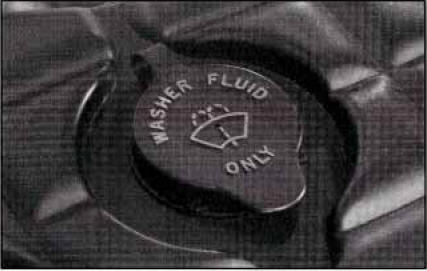
Open the cap labeled WASHER FLUID ONLY. Add washer fluid until the tank is full.
NOTICE:
When using concentrated washer fluid, follow the manufacturer’s instructions for
adding water.
Don’t mix water with ready-to-use washer fluid. Water can cause the solution to freeze and damage your washer fluid tank and other parts of the washer system. Also, water doesn’t clean as well as washer fluid.
Fill your washer fluid tank only three-quarters full when it’s very cold. This allows for expansion if freezing occurs, which could damage the tank if it is completely full.
Don’t use engine coolant (antifreeze) in your windshield washer. It can damage your washer system and paint.
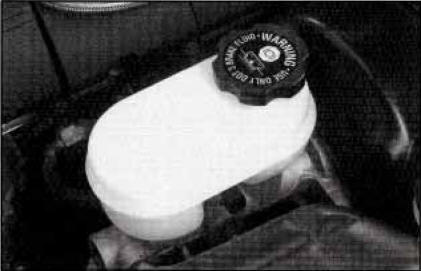
Your brake master cylinder reservoir is here. It is filled with DOT-3 brake fluid.
There are only two reasons why the brake fluid level in the reservoir might go
down.
The first is that the brake fluid goes down to an acceptable level during normal brake lining wear. When new linings are put in , the fluid level goes back up.
The other reason is that fluid is leaking out of the brake system. If it is, you should have your brake system fixed, since a leak means that sooner or later your brakes won’t work well, or won’t work at all.
It isn’t a good idea to “top off’ your brake fluid. Adding brake fluid won’t
correct a leak. If you add fluid when your linings are worn, then you’ll have
too much fluid when you get new brake linings. You should add (or remove) brake
fluid, as necessary, only when work is done on the brake hydraulic system.
Caution
If you have too much brake fluid, it can spill on the engine. The fluid will burn if the engine is hot enough. You or others could be burned, and your vehicle could be damaged. Add brake fluid only when work is done on the brake hydraulic system.
Refer to the Maintenance Schedule to
determine when to check your brake fluid. See “Periodic Maintenance
Inspections” in the Index.
You can check the brake fluid without taking off the cap. Just look at the brake fluid reservoir. The fluid level should be above the MIN mark on the reservoir. If it isn’t, have your brake system checked to see if there is a leak.
After work is done on the brake hydraulic system, make sure the level is between the MIN and MAX marks.
What to Add
When you do need brake fluid, use only DOT-3 brake fluid -- such as Delco
Supreme 11 @ (GM Part
No. 12377967). Use new brake fluid from a sealed container only.
Always clean the brake fluid reservoir cap and the area around the cap before removing it. This will help keep dirt from entering the reservoir.
CAUTION
With the wrong kind of fluid in your brake system, your brakes may not work
well, or they may not even work at all. This could cause a crash. Always use the
proper brake fluid.
NOTICE:
Using the wrong fluid can badly damage brake system parts. For example, just a
few drops of mineral-based oil, such as engine oil, in your brake system can
damage brake system parts so badly that they’ll have to be replaced. Don’t let
someone put in the wrong kind of fluid.
If you spill brake fluid on your vehicle’s painted surfaces, the paint finish
can be damaged. Be careful not to spill brake fluid on your vehicle. If you do,
wash it off immediately. See “Appearance Care” in
the Index.
Brake Wear
Your vehicle has four-wheel disc brakes.
Disc brake pads have built-in wear indicators
that make a high-pitched warning sound when the brake
pads are worn
and new pads are needed. The sound may come and go or be heard all the time your
vehicle is moving (except when
you are pushing on the brake pedal firmly).
Caution
The brake wear warning sound means that soon your brakes won’t work well. That could lead to an accident. When you hear the brake wear warning sound, have your vehicle serviced.
NOTICE:
Continuing to drive with worn-out brake pads could result in costly brake
repair.
Some driving conditions or climates may cause a brake squeal when the brakes are first applied or lightly applied. This does not mean something is wrong with your brakes.
Brake linings should always be replaced as complete axle sets.
See “Brake System Inspection” in Section 7 of this manual under Part C “Periodic Maintenance Inspections.”
Brake Pedal Travel
See your dealer if the brake pedal does not return to normal height, or if there
is a rapid increase in pedal travel. This could be a sign of brake trouble.
Brake Adjustment
As you make brake stops, your disc brakes automatically adjust for wear.
The braking system on a modern vehicle is
complex. Its many parts have to be of top quality and work well together if the
vehicle is to have really good braking. Your vehicle was designed and tested
with top-quality GM brake parts. When you replace parts of your braking system
-- for example, when your brake linings wear down and you have to have new ones
put -in- be sure you get new approved GM replacement parts. If you don’t, your
brakes may no longer work properly. For
example, if someone puts in brake linings that are wrong for your vehicle, the
balance between your front and rear brakes can change -- for the worse. The
braking performance you’ve come to expect can change in many other ways if
someone puts in the wrong replacement brake parts.
Battery
Every new Corvette has a Delco Freedom battery. You never have to add water to
one of these. When it’s time for
a new battery, refer to
"Battery Replacement". Get one that has the
replacement number shown on the
original battery’s label. After the battery has been
replaced, refer to the
“Remote Function
Actuation System” in the Index to resynchronize your transmitter(s).
Vehicle Storage
If you’re not going to drive your vehicle for 25 days or more, remove the black,
negative (-) cable from
the battery. This will help keep your battery from running down.
CAUTION
Batteries have acid that can burn you and gas that can explode. You can be badly
hurt if you aren’t careful. See “Jump Starting” in the Index for tips on working
around a battery without getting hurt.
Contact your dealer to learn how to prepare your vehicle for longer storage periods.
Also, for your audio system, see “Theft-Deterrent Feature” in the Index.
Bulb Replacement
For the proper type of replacement bulb, see
“Replacement Bulbs”
in the Index.
CAUTION:
Halogen bulbs have pressurized gas inside and can burst if you drop or scratch
the bulb. You or others could be injured. Be sure to read and follow the
instructions on the bulb package.
Headlamps/Highbeam
1. The headlamps need to be halfway open. Turn the headlamp switch on, then
quickly back to the parking lamps setting. You may have to do this a few times
to get the half-open position.
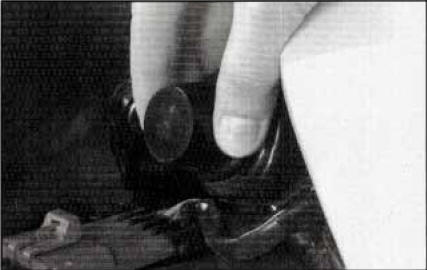
2. You can also open the headlamps manually by turning the adjuster to the left.
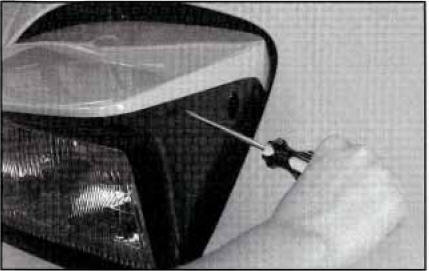
3. Remove the screws on each side of the headlamp bezel.
4. Open the hood.
5. To remove the bezel, pull the sides slightly outward and tilt the bezel forward. Pull the clip centered above the lens outward. Be careful not to scratch the paint.
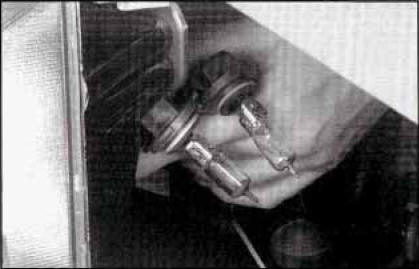
6. Reach behind the lamp and turn the bulb to the left (counterclockwise) to remove it. Don’t touch the halogen bulbs. The inner bulb is the high beam and the outer bulb is the low beam.
7. Disconnect the desired bulb from the wiring harness.
8. Reverse the steps with a new bulb.
1. Remove the front fascia close out panel attaching bolts.
2. Remove the front fascia close out panel.
3. Grasp the cooling duct and pull to release it from the front fascia, then reposition it. This will give you better access to the bulb.
4. Squeeze the tab on the socket and turn it to the left (counterclockwise) to remove the socket with the bulb.
5. Remove the bulb from the socket.
6. Reverse the steps with a new bulb.
Front Sidemarker Lamps
1. Follow Steps 1 through 3 in “Front Turn Signal Lamps” described previously.
2. Turn the socket one-quarter of a turn to the left and pull it out.
3. Pull the bulb straight out of the socket.
4. Reverse the steps with a new bulb.
Rear Turn Signal and Taillamps
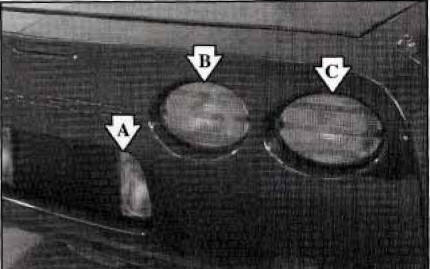
A. Back-up Lamp
B. Inboard Taillamp
C. Outboard Taillamp
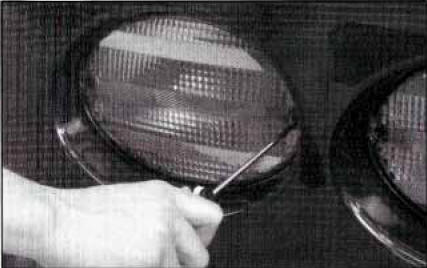
1. Remove the screws.
2. Pull the taillamp housing assembly out.
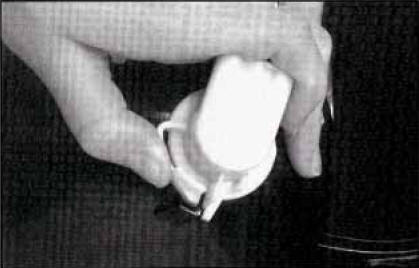
3. To remove the socket with the bulb, squeeze the tab while you turn the socket to the left (counterclockwise).
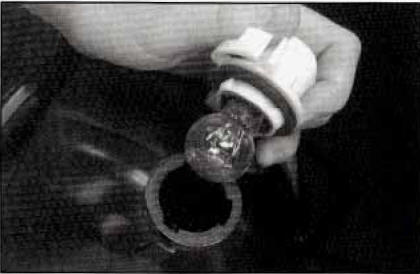
4. Remove the bulb from the socket.
5. Reverse the steps with a new bulb. Back-up Lamps You can access the back-up lamps through the inboard taillamp opening. See “Rear Turn Signal and Taillamps” in the Index.
You can access the back-up lamps through the inboard taillamp opening. See “Rear Turn Signal and Taillamps” in the Index.
1. Squeeze the tab on the socket while turning it to the left to remove it from the assembly.
2. Remove the bulb from the socket.
3. Reverse the steps with a new bulb.
For any bulb replacement procedures not listed here, please see your dealership.
Windshield Wiper Blade Replacement
It’s a good idea to clean or replace the wiper blade assembly every six months.
For the proper windshield wiper blade length and type, see
“Replacement
Wiper Blades” .
NOTICE:
Use care when removing or installing a blade assembly. Accidental bumping can
cause the arm to fall back and strike the windshield.
To remove the wiper blade assembly:
1. Open the hood to gain access to the windshield wipers.
2. Lift the wiper arm until it locks into a vertical position.
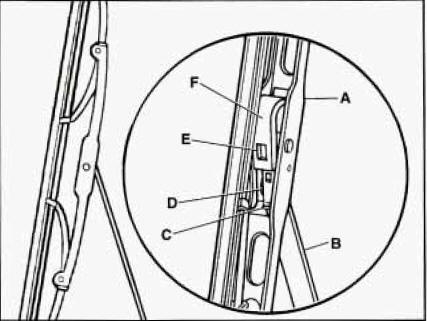
A. Blade Assembly
B. Arm Assembly
C. Locking Tab
D. Blade Pivot
E. Hook Slot
E ArmHook
3.Press down on the blade assembly pivot locking tab. Pull down on the blade assembly to release it from the wiper arm hook.
4.Remove the insert from the blade assembly. The insert has two notches at one end that are locked by the bottom claws of the blade assembly. At the notched end, pull the insert from the blade assembly.
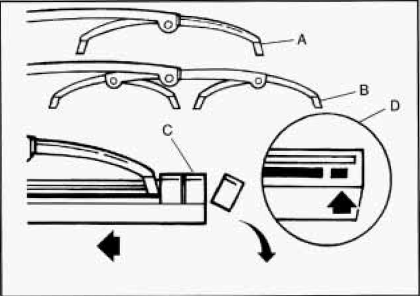
To install the new wiper insert:
1. Slide the insert (D), notched end last, into the end with two blade claws (A). Slide the insert all the way through the blade claws at the opposite end (B). Plastic caps (C) will be forced off as the insert is fully installed.
2. Be sure the notches are locked by the bottom claws. Make sure that all other claws are properly locked on both sides of the insert slots.
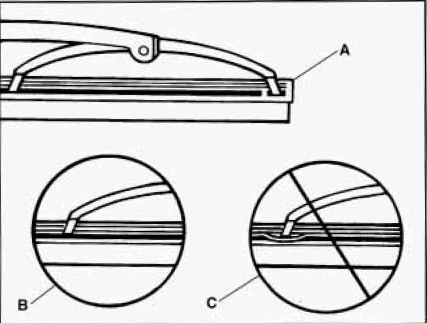
A. Claw in Notch
B. Correct Installation
C. Incorrect Installation
3. Put the blade assembly pivot in the wiper arm hook. Pull up until the pivot
locking tab locks in the hook slot.
4. Carefully lower the wiper arm and blade assembly into the windshield.
Tires
Your new vehicle comes with high-quality tires made by a leading tire
manufacturer. If you ever have questions about your tire warranty and where to
obtain service, see your Corvette Warranty booklet for details.
CAUTION:
Poorly maintained and improperly used tires are dangerous.
Overloading your tires can cause overheating as a result of too much friction. You could have an air out and a serious accident. See ‘Zoading Your Vehicle” in the Index.
Underinflated tires pose the same danger as overloaded tires. The resulting accident could cause serious injury. Check all tires frequently to maintain the recommended pressure. Tire pressure should be checked when your tires are cold.
Overinflated tires are more likely to be
cut, punctured or broken by a sudden impact -- such as when you hit a
pothole.
Keep tires at the recommended pressure.
Worn, old tires can cause accidents. If your tread is badly worn, or if your tires have been damaged, replace them.
Extended Mobility Tires
Your vehicle, when new, had Goodyear Extended Mobility Tires (EMT). There’s no
spare tire, no tire changing equipment and no place to store a tire in the
vehicle. Extended Mobility Tires perform so well without any air that a Tire
Pressure Monitor (TPM) is used to alert you if a tireh as lost pressure.
The Tire Pressure Monitor (TPM) has a sensor on each road wheel that transmits to a receiver on the instrument panel.
The system operates on a radio frequency subject to Federal Communications Commission (FCC) Rules and with Industry and Science Canada.
This device complies with Part 15 of the FCC Rules. Operation is subject to the following two conditions: (1) this device may not cause harmful interference, and (2) this device must accept any interference received, including interference that may cause undesired operation.
This device complies with RSS-210 of Industry and Science Canada. Operation is subject to the following two conditions: (1) this device may not cause interference, and (2) this device must accept any interference received, including interference that may cause undesired operation of the device. Changes or modifications to this system by other than an authorized service facility could void authorization to use this equipment.
If a tire’s inflation pressure is between 5 psi (35 kPa) and 25 psi (170 kPa), you will see a message on the Driver Information Center. This message will show which tire is underinflated and two chimes will sound. An example would be LOW TIRE PRESSURE-LR. This would mean that the inflation pressure in your left rear tire is between 5 psi (35 P a ) and 25 psi (170 P a ) . If the inflation pressure in the tire drops below 5 psi (35 Ea), the message would read FLAT TIRE-LR and four chimes will sound. See “Driver Information Center” in the Index.
The TPM will also alert you if a tire’s pressure is higher than 42 psi (290 Wa). The message will show which tire is overinflated and two chimes will sound. An example would be HIGH PRESSURE-LR. This would mean that the inflation pressure in your left rear tire is higher than 42 psi (290 kPa). See “Driver Information Center” in the Index.
If a tire pressure message appears on the Driver Information Center, stop as soon as you can. Have the tire pressures checked and set to those shown on your Tire Loading Information label. See “Inflation -- Tire Pressure” in the Index.
CAUTION:
When the LOW TIRE PRESSURE or FLAT TIRE message is displayed on the Driver
Information Center, your vehicle’s handling capabilities will be reduced during
severe maneuvers. If you drive too fast, you could lose control of your vehicle.
You or others could be injured, Don’t drive ove5r5 mph (90 km/h) when the LOW
TIRE PRESSURE or FLAT TIRE message is displayed. Drive cautiously, and check
your tire pressures as soon as you can.
If a tire goes flat, you won’t need to stop on the side of the road to change the tire. You can just keep on driving. The shorter the distance you drive and the slower the speed, the greater the chance that the tire will not have to be replaced. If you drive on a deflated EMT for 50 miles (80 km) or less and at speeds of 55 mph (90 km/h) or less, there is a good chance that the tire can be repaired. The tire can operate effectively with no air pressure for up to 200 miles (320 km) at speeds up to 55 mph (90 km/h), but the tire would then have to be replaced. When a tire is filled with air, it provides a cushion between the road and the wheel. Because you won’t have this cushion when driving on a deflated tire, try to avoid potholes that could damage your wheel and require replacement of it.
Some road hazards can damage a tire beyond
repair. This damage could occur even before you’ve driven on the tire in a
deflated condition. When a tire has been damaged, or if you’ve driven any
distance on a deflated EMT, check with an authorized Goodyear EMT Service Center
to determine whether the tire can be repaired or should be replaced. To maintain
your vehicle’s extended mobility feature, all replacement tires must be Extended
Mobility Tires. As soon as possible, contact the nearest authorized Chevrolet or
Goodyear EMT servicing facility for inspection and repair or replacementC. all
Chevrolet at 1-800-CHEV-USA (1-800-243-8872) or Goodyear at 1-800-789-9878
24-hours a day for
information on the location of the nearest EMT servicing facility. In Canada,
contact the Customer Communication Center at 1-800-263-3777, or Canadian
Roadside Assistance at 1-800-268-6800. You can also use the Goodyear number
listed above to locate an authorized EMT servicing facility.
CAUTION:
Extended mobility tires are constructed differently than other tires and could
explode during improper service. You or others could be injured or killed if you
attempt to repair, replace, dismount, or mount an extended mobility tire. Let
only an authorized Goodyear EMT Service Center repair, replace, dismount and
mount extended mobility tires.
The valve stems on your extended mobility tires have sensors that are part of the TPM. These sensors contain batteries which are designed to last for 10 years under normal driving conditions. See your dealer if you ever need to have a wheel replaced, or if the batteries in the sensors ever need replacement.
NOTICE:
Using liquid sealants can damage the tire valves and tire pressure monitor
sensors in your extended mobility tires. This damage would not be covered by
warranty. Don’t use liquid sealants in your extended mobility tires.
If you feel that winter tires are needed for
your driving conditions, Goodyear Eagle M+S EMT tires are available in your
original equipment sizes from an authorized Goodyear EMT retailer. These tires
will improve snow traction while maintaining your Corvette’s extended mobility
feature. When using winter tires on your vehicle, be sure to use them on
all four wheels see “Buying New Tires” in the Index.
Inflation -- Tire Pressure
The Tire-Loading Information label, which is on the rear edge of the driver’s
door shows the correct inflation pressures for your tires when they’re cold.
“Cold” means your vehicle has been sitting for at least three hours or driven no
more than 1 mile (1.6 km).
NOTICE:
Don’t let anyone tell youth at underinflation or
overinflation is all right. It’s not. If your tires don’t have enough
air(underinflation), you can get the following:
Too much flexing
Too much heat
Tire overloading
Bad wear
Bad handling
Bad fuel economy.
If your tires have too much air (overinflation) you can get the following:
Unusual wear
Bad handling
Rough ride
Needless damage from road hazards.
When to Check
Check your tires once a month or more.
How to Check
With the Tire Pressure Monitor, you can check tire inflation pressures while
driving. After you’ve reached a speed of 15 mph (24 kmh) or more, press and
release the GAGES button on the Driver Information Center (DIC) until the front
tire pressures are displayed. Then, press and release the GAGES button for the
rear tire pressures. If the display doesn’t show tire pressure, or if the
SERVICE TIRE MON SYS message appears, see your dealer for service.
Tire Rotation
The tires on your Corvette are directional and are different sizes front to
rear. Due to this, your tires should not be rotated. Each tire and wheel should
be used only in the position it is in.
When It’s Time for New Tires
One way to tell when it’s time for new tires is to check the treadwear
indicators, which will appear when your tires have
only 1/16 inch (1.6 mm) or less of tread remaining.
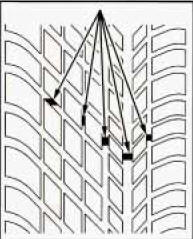
You need a new tire if any of the following statements are true:
You can see the indicators at three or more places around the tire.
You can see cord or fabric showing through the tire’s rubber.
The tread or sidewall is cracked, cut or snagged deep enough to show cord or fabric.
The tire has a bump, bulge or split.
The tire has a puncture, cut or other damage that can’t be repaired well because of the size or location of the damage.
Buying New Tires
To find out what kind and size of tires you need, look at the Tire-Loading
Information label.
The tires installed on your vehicle when it was new had a Tire Performance Criteria Specification (TPC Spec) number on each tire’s sidewall. When you get new tires, get ones with that same TPC Spec number. That way your vehicle will continue to have tires that are designed to give proper endurance, handling, speed rating, traction, ride and other things during normal service on your vehicle. If your tires have an all-season tread design, the TPC number will be followed by an “MS” (for mud and snow).
If you ever replace your tires with those not having a TPC Spec number, make sure they are the same size, load range, speed rating and construction type (bias, bias-belted or radial) as your original tires.
CAUTION:
Mixing tires could cause you to lose control while
driving. If you mix tires of different sizes (other than those originally
installed on your vehicle) or types (radial and bias-belted tires), the vehicle
may not handle properly, and you could havea
crash. Using tires of different sizes (other than those originally installed on
your vehicle) may also cause damage to your vehicle. Be sure to use the correct
size and type tires on all four wheels.
If you feel that winter tires are needed, see “Extended Mobility Tires”.
CAUTION:
If you use bias-ply tires on your vehicle, the wheel rim
flanges could develop cracks after many miles of driving. A tire and/or wheel
could fail suddenly, causing a crash. Use only radial-ply tires with the wheels
on your vehicle.
Uniform Tire Quality Grading
The following information relates to the system developed by the United States
National Highway Traffic Safety Administration, which grades tires by treadwear,
traction and temperature performance. (This applies only to vehicles sold in the
United States.) The grades are molded on the sidewalls of most passenger car
tires. The Uniform Tire Quality Grading system does not apply to deep tread,
winter-type snow tires, space-saver or temporary use spare tires, tires with
nominal rim diameters of 10 to 12 inches (25 to 30 cm), or to some
limited-production tires.
While the tires available on General Motors passenger cars and light trucks may vary with respect to these grades, they must also conform to Federal safety requirements and additional General Motors Tire Performance Criteria (TPC) standards.
Treadwear
The treadwear grade is a comparative rating based on the wear rate of the tire
when tested under controlled conditions on a specified government test course.
For example, a tire graded 150 would wear one and a half (1 1/2) times as well
on the government course as a tire graded 100. The relative performance of tires
depends upon the actual conditions of their use, however, and may depart
significantly from the norm due to variations in driving habits, service
practices and differences in road characteristics and climate.
Traction -- A, B, C
The traction grades, from highest to lowest are A, B, and C, and they represent
the tire’s ability to stop on wet pavement as measured under controlled
conditions on specified government test surfaces of asphalt and concrete. A tire
marked C may have poor traction performance.
Warning: The traction grade assigned to this tire
is based on braking (straight ahead) traction tests and does not
include cornering (turning) traction.
Temperature -- A, B, C
The temperature grades are A (the highest), B, and C, representing the tire’s
resistance to the generation of heat and its ability to dissipate heat when
tested under controlled conditions on a specified indoor laboratory test wheel.
Sustained high temperature can cause the material of the tire to degenerate and
reduce tire life, and excessive temperature can lead to sudden tire failure. The
grade C corresponds to a level of performance which all passenger car tires must
meet under the Federal Motor Vehicle Safety Standard N o. 109. Grades B and A
represent higher levels of performance
on the laboratory test wheel than the minimum required by law.
Warning: The temperature grade for this tire is established for a tire that is properly inflated and not overloaded. Excessive speed, underinflation, or excessive loading, either separately or in combination, can cause heat buildup and possible tire failure.
Wheel Alignment and Tire Balance
The wheels on your vehicle were aligned and balanced carefully at the factory to
give you the longest tire life and best overall performance.
Scheduled wheel alignment and wheel balancing are not needed. However, if you notice unusual tire wear or your vehicle pulling one way or the other, the alignment may need to be reset. If you notice your vehicle vibrating when driving on a smooth road, your wheels may need to be rebalanced.
Wheel Replacement
Replace any wheel that is bent, cracked, or badly rusted or corroded. If wheel
nuts keep coming loose, the wheel, wheel bolts and wheel nuts should be
replaced. If the wheel leaks air, replace it (except some aluminum wheels, which
can sometimes be repaired). See your dealer if any of these conditions exist.
Your dealer will know the kind of wheel you need.
Each new wheel should have the same load-carrying capacity, diameter, width, offset and be mounted the same way as the one it replaces.
If you need to replace any of your wheels, wheel bolts or wheel nuts, replace them only with new GM original equipment parts. This way, you will be sure to have the right wheel, wheel bolts and wheel nuts for your Corvette model.
CAUTION:
Using the wrong replacement wheels, wheel bolts or wheel
nuts on your vehicle can be dangerous. It could affect the braking and handling
of your vehicle, make your tires lose air and make you lose control. You could
have a collision in which you or others could be injured. Always use the correct
wheel, wheel bolts and wheel nuts for replacement.
NOTICE:
The wrong wheel can also cause problems with bearing life, brake cooling,
speedometer or odometer calibration, headlamp aim, bumper height, vehicle ground
clearance and tire clearance to the body and chassis.
CAUTION:
Rust or dirt on the wheel, or on the parts to which it is
fastened, can make the wheel nuts become loose after a time. The wheel could
come off and cause an accident. When you change a wheel, remove any rust or dirt
from the places where the wheel attaches to the vehicle. In an emergency, you
can use a cloth or paper towel to do this; but be sure to use a scraper or wire
brush later, if you need to,to get all the rust or dirt off.
CAUTION:
Never use oil or grease on studs or nuts. If you do, the
nuts might come loose. Your wheel could fall off, causing a serious accident.
Caution
Incorrect wheel nuts or improperly tightened wheel nuts can cause the wheel to become loose and even come off. This could lead to an accident. Be sure to use the correct wheel nuts. If you have to replace them, be sure to get new GM original equipment wheel nuts.
NOTICE:
Improperly tightened wheel nuts can lead to brake pulsation and rotor
damage. To avoid expensive brake repairs, evenly tighten the wheel nuts in the
proper sequence and to the proper torque specification.
Caution
Putting a used wheel on your vehicle is dangerous. You can’t know how it’s
been used or how far it’s been driven. It could fail suddenly and cause an
accident. If you have to replace a wheel, use a new GM original equipment wheel.
Using the Wheel Lock Key
The wheel lock key sits in a small depression in the trunk rail directly
under the left-hand rear compartment cover.
Your vehicle’s wheel lock key has a unique
registration number. The registration number is printed on a card
included in your lock nut package. Also, on this card, is lost key replacement
information. This number is not
recorded by GM or your dealer, so be sure not to lose this card. You will need
the information if you ever lose
your wheel lock key.
If you or someone else is going to remove the
wheels on your vehicle, make sure that the special wheel nut socket
and wheel lock key are being used.
NOTICE:
Your wheels could be damaged if the wheel nut socket is not used to remove your
vehicle’s wheels. The wheel nut socket can be used with an air wrench or a
torque wrench. The wheel lock key can be used with a torque wrench, but not with
an air or impact wrench.
NOTICE:
Your wheel lock key or lock nuts could be damaged if an air or impact wrench is
used with this key.
NOTICE:
Don’t use tire chains. They can damage your vehicle because there’s not enough
clearance. Use another type of traction device only if its manufacturer
recommends it for use on your vehicle and tire size combination and road
conditions. Follow that manufacturer’s instructions. To help avoid damage to
your vehicle, drive slowly, readjust or remove the
device if it’s contacting your vehicle, and don’t spin your wheels.
If you do find traction devices that will fit, install them on the rear tires.
Appearance Care
Remember, cleaning products can be hazardous. Some are toxic. Others can burst
into flame if you strike a match or get them on a hot part of the vehicle. Some
are dangerous if you breathe their fumes in a closed space. When you use
anything from a container to clean your vehicle, be sure to follow the
manufacturer’s warnings and instructions. And always open your doors or windows
when you’re cleaning the inside.
Never use these to clean your vehicle:
Gasoline
Benzene
Naphtha
Carbon Tetrachloride
Acetone
Paint Thinner
Turpentine
Lacquer Thinner
Nail Polish Remover
They can all be hazardous -- some more than others -- and they can all damage
your vehicle, too.
Don’t use any of these unless this manual says you can. In many uses, these will damage your vehicle:
Alcohol
Laundry Soap
Bleach
Reducing Agents
Cleaning the Inside of Your Vehicle
Use a vacuum cleaner often to get rid of dust and loose dirt. Wipe vinyl or
leather with a clean, damp cloth. Your dealer has two cleaners, Multi-Purpose
Interior Cleaner and Capture Non-Solvent Dry Spot and Soil Remover. They will
clean normal spots and stains very well. You can get cleaning
products from “Appearance Care and Materials”.
Here are some cleaning tips:
Always read the instructions on the cleaner label.
Clean up stains as soon as you can -- before they set.
Carefully scrape off any excess stain.
Use a clean cloth or sponge, and change to a clean area often. A soft brush may be used if stains are stubborn.
If a ring forms after spot cleaning, clean the entire area immediately or it will set.
Fabric Protection
Your Corvette has carpet that has been treated with Scotchgard" Fabric
Protector, a 3M product. It protects fabrics by repelling oil and water, which
are the carriers of most stains. Even with this protection, you still need to
clean your carpet often to keep it looking new. Use Carpet and Upholstery Cleaner
Further information on cleaning is available by calling 1-800-433-3296 (in Minnesota, 1-800-642-6167).
Cleaning Vinyl
Use warm water and a clean cloth.
Rub with a clean, damp cloth to remove dirt. You may have to do it more than once. Use this professional Leather Cleaner .
Things like tar, asphalt and shoe polish will stain if you don't get them off quickly. Use a clean cloth and a Leather Cleaner ..
Cleaning Coated Moldings
These moldings are around the hatch opening in your Corvette's rear area.
When lightly soiled, wipe with a sponge or soft lint free cloth dampened with water.
When heavily soiled, use a cleaner specially made for this purpose.
Cleaning Leather
Use a soft cloth with lukewarm water and a mild soap or saddle soap and wipe dry
with a soft cloth. Then, let the
leather dry naturally. Do not use heat to dry.
For stubborn stains, use a leather cleaner. See your dealer for this product.
Never use oils, varnishes, solvent-based or abrasive cleaners, furniture polish or shoe polish on leather.
Soiled or stained leather should be cleaned immediately. If dirt is allowed to work into the finish, it can harm the leather.
Cleaning the Top of the Instrument Panel
Use only mild soap and water to clean the top surfaces of the instrument panel
unless you have a
specialty product.
Sprays containing silicones or waxes may cause .annoying reflections in the
windshield and even make it difficult to see through the windshield under
certain conditions.
Cleaning Interior Plastic Components
Use only a mild soap and water solution on a soft cloth or sponge unless you
have a
specialty product. Commercial
cleaners may affect the
surface finish.
Cleaning Soft-Touch Paint Surfaces
Use only mild soap and water to clean the Soft-Touch paint surfaces in your
Corvette or a
product specially made for this purpose.
Cleaning the Security Shade and
Convenience Net
Wash with warm water and mild detergent, rinse with cold water and tumble dry on
low. Do not use chlorine bleach.
Care of Safety Belts
Keep belts clean and dry.
Caution
Do not bleach or dye safety belts. If you do, it may
severely weaken them. In a crash, they might not be able to provide adequate
protection. Clean safety belts only with mild soap and lukewarm water.
Cleaning Glass Surfaces
Glass should be cleaned often.
Glass Cleaner or a
liquid household glass cleaner will remove normal tobacco smoke and dust films
on interior glass.
Don’t use abrasive cleaners on glass, because
they may cause scratches. Avoid placing decals on the inside rear
window, since they may have to be scraped off later. If abrasive cleaners are
used on the inside of the rear window, an electric defogger element may be
damaged. Any temporary license should not be attached across the defogger grid.
Cleaning the Outside of the Windshield and
Wiper Blades
If the windshield is not clear after using the windshield washer, or if the
wiperblade chatters when running,
wax, sap or other material may be on the blade or windshield.
Clean the outside of the windshield with Windshield Cleaner (non-scratching glass cleaning powder). The windshield is clean if beads do not form when you rinse it with water.
If you use a glass treatment or conditioner containing ethyl alcohol or ethyl sulfate on your glass, be sure to remove the acrylic roof panel, if so equipped. These products may damage the panel.
Grime from the windshield will stick to the wiper blades and affect their performance. Clean the blade by wiping vigorously with a cloth soaked in full-strength windshield washer solvent. Then rinse the blade with water.
Check the wiper blades and clean them as necessary; replace blades that look worn.
Weatherstrips
Silicone grease on weatherstrips will make them last longer, seal better, and
not stick or squeak. Apply
silicone grease with a clean cloth at least every six
months. During very cold, damp weather more frequent application may be
required. (See “Recommended Fluids and
Lubricants” in the Index.)
Cleaning a Removable Roof Panel
Special care is necessary when cleaning, removing and/or storing the roof panel.
Flush with water to remove dust and dirt, then dry the panel.
Clean the panel with
Glass Cleaner.
Leave the cleaner on the panel for one minute, then wipe the
panel with a soft, lint-free cloth.
Don’t use abrasive cleaning materials.
If water drops are frequently allowed to dry on the roof panel, impurities in the water will adhere to the top. These impurities may etch or mar the finish. When the panel gets wet, you should dry it off.
NOTICE:
Do not use a glass treatment or conditioner containing ethyl alcohol or ethyl
sulfate on the roof panel. These products may damage the panel.
Cleaning the Outside of
Your Vehicle
The paint finish on your vehicle provides beauty, depth of color, gloss
retention and durability.
Washing Your Vehicle
The best way to preserve your vehicle’s finish is to keep it clean by washing it
often with lukewarm or cold water.
Don’t wash your vehicle in the direct rays of the sun. Don’t use strong soaps or chemical detergents. Use liquid hand, dish or car washing (mild detergent) soaps. You can get approved cleaning products from your here. (See “Appearance Care and Materials” in the Index.) Don’t use cleaning agents that are petroleum based, or that contain acid or abrasives. All cleaning agents should be flushed promptly and not allowed to dry on the surface, or they could stain. Dry the finish with a soft, clean chamois or an all-cotton towel to avoid surface scratches and water spotting. High pressure car washes may cause water to enter your vehicle.
NOTICE:
Conveyor systems on some automatic car washes may damage a Corvette. They may
not have enough clearance for the undercarriage or for the wide rear tires.
Check with the manager before using a car wash.
Cleaning Exterior Lamps/Lenses
Use lukewarm or cold water, a soft cloth and a liquid hand, dish or
car washing
(mild detergent) soap to clean exterior lamps and lenses. Follow instructions
under “Washing Your Vehicle.”
Finish Care
Occasional waxing or mild polishing of your vehicle by hand may be necessary to
remove residue from the paint
finish. You can get approved cleaning products
like
Adam's Butter Wax
(See
“Appearance Care and Materials” in the Index.)
Your Corvette has a “basecoat/clearcoat” paint finish. The clearcoat gives more depth and gloss to the colored basecoat. Always use waxes and polishes that are non-abrasive and made for a basecoat/clearcoat paint finish.
NOTICE:
Machine compounding or aggressive polishing on a basecoat/clearcoat paint finish
may dull the finish or leave swirl marks.
Foreign materials such as calcium chloride and other salts, ice melting agents, road oil and tar, tree sap, bird droppings, chemicals from industrial chimneys, etc., can damage your vehicle’s finish if they remain on painted surfaces. Wash the vehicle as soon as possible. If necessary, use non-abrasive cleaners that are marked safe for painted surfaces to remove foreign matter.
Exterior painted surfaces are subject to aging, weather and chemical fallout that can take their toll over a period of years. You can help to keep the paint finish looking new by keeping your vehicle garaged or covered whenever possible.
Cleaning Your Convertible Top
Your convertible top should be cleaned often. If you use an automatic car wash,
use one with water jets and hanging cloths. High pressure car washes may cause
water to enter your vehicle.
When you hand wash the top, do it in partial shade. Use a mild soap, lukewarm water and a soft sponge. A chamois or cloth may leave lint on the top, and a brush can chafe the threads in the top fabric. Don’t use detergents, harsh cleaners, solvents or bleaching agents.
Wet the entire vehicle and wash the top
evenly to avoid spots or rings. Let the soap remain on the fabric for
a few minutes. When the top is really dirty, use a mild foam-type cleaner.
Thoroughly rinse the entire vehicle, then let the top dry in direct sunlight.
To protect the convertible top:
After you wash the vehicle, make sure the top is completely dry before you lower it.
Don’t get any cleaner on the vehicle’s painted finish; It could leave streaks
If you decide to go through an automatic car wash, ask the manager if the equipment could damage your top.
Cleaning Aluminum Wheels
Keep your wheels clean using a soft clean cloth with mild soap and water. Rinse
with clean water. After rinsing thoroughly, dry with a soft clean towel . A wax
may then be applied.
The surface of these wheels is similar to the painted surface of your vehicle. Don’t use strong soaps, chemicals, abrasive polishes, abrasive cleaners or abrasive cleaning brushes on them because you could damage the surface.
Don’t take your vehicle through an automatic car wash that has silicon carbide tire cleaning brushes. These brushes can also damage the surface of these wheels.
Cleaning Tires
To clean your tires, use a stiff brush with a tire cleaner.
NOTICE:
When applying a tire dressing always take care to wipe off any overspray or
splash from all painted surfaces on the body or wheels of the vehicle.
Petroleum-based products may damage the paint finish.
Finish Damage
Any stone chips, fractures or deep scratches in the finish should be repaired
right away.
Minor chips and scratches can be repaired with touch-up materials available from your dealer or other service outlets. Larger areas of finish damage can be corrected in your dealer’s body and paint shop.
Magnesium Wheel Finish
NOTICE:
Improper paint repair or refinishing can cause corrosion damage to a magnesium
wheel. See your dealer if a magnesium wheel needs paint repair or refinishing.
Underbody Maintenance
Chemicals used for ice and snow removal and dust control can collect on the
underbody. If these are not removed, accelerated corrosion (rust) can occur on
the underbody parts such as fuel lines, frame, floor pan and exhaust system even
though they have corrosion protection.
At least every spring, flush these materials from the underbody with plain water. Clean any areas where mud and other debris can collect. Dirt packed in closed areas of the frame should be loosened before being flushed. Your dealer or an underbody car washing system can do this for you.
NOTICE:
Don’t use corrosive or acidic cleaning agents, engine degreasers, aluminum
cleaning agents or other harsh solvents to clean fiberglass springs; they’ll
damage the springs.
Chemical Paint Spotting
Some weather and atmospheric conditions can create a chemical fallout. Airborne
pollutants can fall upon and
attack painted surfaces on your vehicle. This damage can take two forms:
blotchy, ringlet-shaped discolorations, and small irregular dark spots etched
into the paint surface.
Although no defect in the paint job causes this, GM will repair, at no charge to the owner, the surfaces of new vehicles damaged by this fallout condition within 12 months or 12,000 miles (20 000 km) of purchase, whichever occurs first.
Appearance Care Materials Chart
PART NUMBER SIZE DESCRIPTION USAGE
994954 23 in. x 25 in. Polishing Cloth - Wax Treated Exterior polishing cloth
1050172
1050173 02. (0.473 L) Chrome Cleaner and Polish 16 Use on chrome, stainless
steel, nickel, copper and brass
16 02. (0.473 L) Tar and Road Oil Remover Removes tar, road oil and asphalt
1050174 I 16 oz. (0.473 L) I White Sidewall Tire Cleaner I Removes soil and
black marks from whitewalls
1050214 I 32 oz. (0.946 L) I Vinyl Cleaner I Cleans vinyl tops, upholstery and
convertible tops
I
1050427 I 23 02. (0.680 L) I Glass Cleaner I Removes dirt, grime, smoke and
fingerprints
1052870 I 16 02. (0.473 L) I Wash Wax Concentrate I Cleans and lightly waxes
1052918** I 8 02. (0.237 L) I Armor AUT’ Protectant I Protects leather, wood,
acrylics, Plexiglas , plastic,
rubber and vinyl
1052925 I 16 02. (0.473 L) I Multi-PCurlepaonsee rI nterior I Cleans carpets,
saenadts ,f lionoterr mioar ttsr im, door panels
1052929 I 16 oz. (0.473 L) I Wheel Cleaner I Spray on and rinse with water
1052930
12345721 2.5 sq. ft. Synthetic Chamois Shines vehicle without scratching
12345002 16 oz. (0.473 L) Armor All TM Cleaner Cleans and shines a variety of
surface types
8 02. (0.237 L) Capture Dry Spot Remover Attracts, absorbs and removes soils
12345725
See your General Motors Parts Department for these products. ** Not recommended
for use on instrument panel vinyl.
16 oz. (0.473 L) 12377S9u84rf ace Cleaner Removes contaminants, blemishes and
swirl marks
12377966 16 02. (0.473 L) Wax Removes light scratches and oxidation and protects
finish Cleaner
12377964 16 02. (0.473 L) Finish Enhancer Removes dust, fingerprints and surface
contaminants
12 02. (0.354 L) Silicone Tire Shine Spray on tire shine
See “Fluids and Lubricants” in the Index.
Vehicle Identification Number (VIN)

This is the legal identifier for your vehicle. It appears on a plate in the front comer of the instrument panel, on the driver’s side. You can see it if you look through the windshield from outside your vehicle. The VIN also appears on the Vehicle Certification and Service Parts labels and the certificates of title and registration.
Engine Identification
The 8th character in your VIN is the engine code. This
code will help you identify your engine, specifications
and replacement parts.
Service Parts
Identification Label
You’ll find this label on the cover assembly for the rear left-hand compartment
storage pocket. It’s very helpful if you ever need to order parts. On this label
is:
your VIN,
the model designation,
paint information and
a list of all production options and special
Be sure that this label is not removed from the vehicle. equipment.
Electrical System
Add-on Electrical Equipment
NOTICE:
Don’t add anything electrical to your vehicle unless you check with your dealer
first. Some electrical equipment can damage your vehicle and the damage wouldn’t
be covered by your warranty. Some add-on electrical equipment
can keep other components from working as they should.
Your vehicle has an air bag system. Before
attempting to add anything electrical to your vehicle, see “Servicing
Your Air Bag-Equipped Corvette” in the Index.
Accessory Power Plug
This plug can be used to connect electrical equipment such as a cellular phone
or CB radio. The accessory
power plug is located behind the passenger side toe-board at the top left corner
near the body control module. Be sure to follow the installation instructions
included with the equipment.
To use the accessory power plug:
Remove the toe-board panel by lifting up on the latches at the top of each corner of the panel.
Locate the black connector at the left top corner of the compartment near the body control module above the two white diagnostic connectors.
Disconnect the connector pigtail by pulling forward on the plastic locking tab and pull the connection apart from the wire harness.
The plug has three separate wires:
The orange wire connects to battery power.
The yellow wire connects to ignition power. Power is only available in the ignition ON position.
The black wire connects to ground.
NOTICE:
When using the accessory plug:
DO NOT splice wires directly in to the vehicle electrical wire harness. If done incorrectly, splicing may cause damage to your electrical system and would not be, covered by the vehicle’s warranty.
The maximum load of any electrical equipment should not exceed 15 amps.
Be sure to turn off any electrical
equipment when not in use. Leaving electrical equipment on for extended
periods of time
can drain your battery.
DO NOT use this plug if the electrical equipment requires frequent connecting and disconnecting. This may cause excessive wear on the accessory plug and damage your electrical system and the damage would not be covered by your warranty.
Headlamps
The headlamp wiring is protected by a circuit breaker. An electrical overload
will cause the lamps to go on and off, or in some cases to remain off. If this
happens, have your headlamp wiring checked right away.
Windshield Wipers
The windshield wiper motor is protected by a fuse and an internal circuit
breaker. If the motor overheats due to heavy snow, etc., the wiper will stop
until the motor cools. If the overload is caused by some electrical problem and
not snow, etc., be sure to get it fixed.
Power Windows and Other Power Options
Circuit breakers protect the power seats and other power accessories. When the
current load is too heavy, the circuit breaker opens and closes, protecting the
circuit until the problem is fixed or goes away.
Fuses and Circuit Breakers
The wiring circuits in your vehicle are protected from short circuits by a
combination of maxi-fuses, mini-fuses and circuit breakers. This greatly reduces
the chance of fires caused by electrical problems. replace a bad fuse with a new
one of the identical size and rating.
If you ever have a problem on the road and don’t have a spare fuse, you can borrow one that has the same amperage. Just pick some feature of your vehicle that you can get along without -- like the radio or cigarette lighter -- and use its fuse, if it is the correct amperage. Replace it as soon as you can.
Instrument Panel Fuse Block
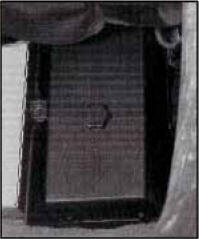
The interior fuse center is on the passenger’s side of the vehicle, under the instrument panel and under the toe-board. Remove the toe-board and carpet covering to access the fuse block. Then turn the fuse block door knob and pull the door to access the fuses.
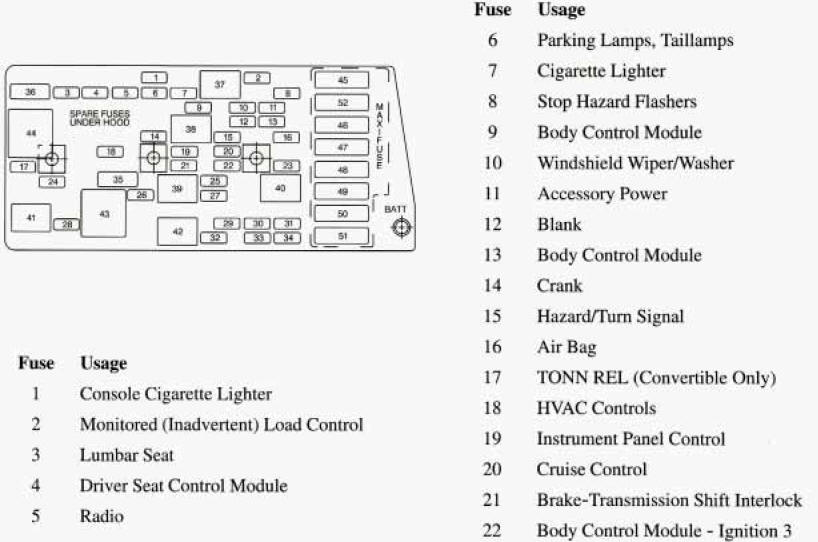
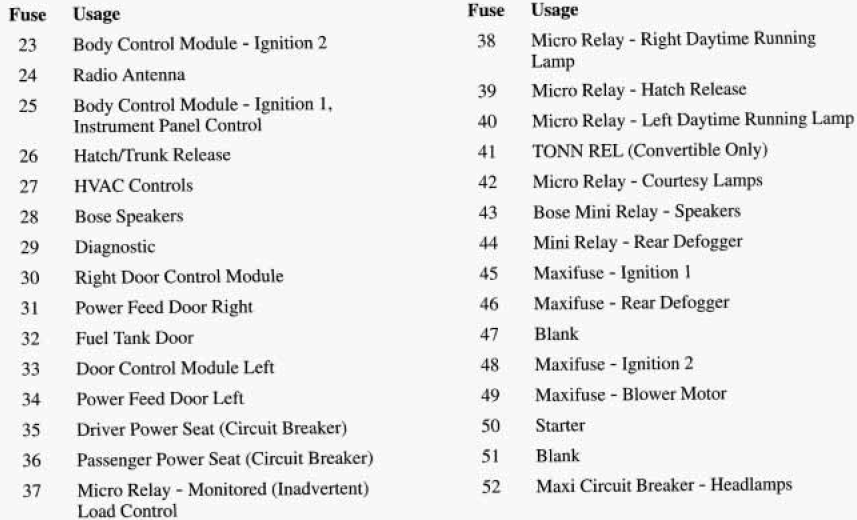
Engine Compartment Fuse Block
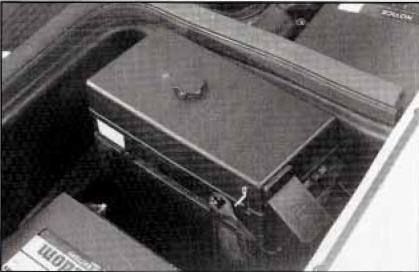
There is one fuse block in the engine compartment located on the passenger’s
side of the vehicle infront of the battery.
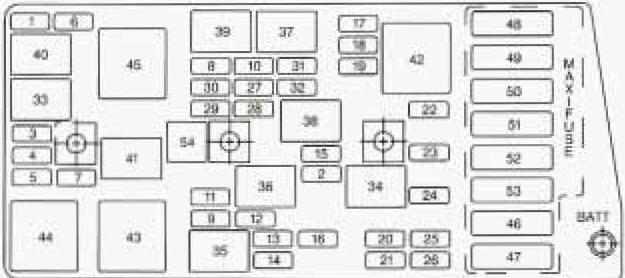
| Fuse | Usage |
| 1 | ABS TRANS |
| 2 | Approach |
| 3 | Right Headlamp Motor |
| 4 | Left Headlamp Motor |
| 5 | BLANK |
| 6 | Fog Lamps |
| 7 | Selective Real Time Damping |
| 8 | Headlamp Low Beam Right |
| 9 | Headlamp High Beam Right |
| 10 | Headlamp Low Beam Left |
| 11 | Horn |
| 12 | Headlamp High Beam Left |
| 13 | Fuel Pump |
| 14 | Cooling Fan - Ignition 3 |
| 15 | Oxygen Sensor |
| 16 | Powertrain Control Module |
| 17 | Throttle Control |
| 18 | Injector 2 |
| 19 | Engine Ignition |
| 20 | Blank |
| 21 | Blank |
| 22 | Injector 1 |
| 23 | Powertrain Control Module |
|
24 |
Air Conditioning |
| 25 | Blank |
| 26 | Blank |
| 27 | Spare |
| 28 | Spare |
| 29 | Spare |
| 30 | Spare |
| 31 | Spare |
| 32 | Spare |
| 33 | Micro Relay - Air Pump |
| 34 | Micro Relay - Air Conditioner and Clutch |
| 35 | Micro Relay - Fuel Pump |
| 36 | Micro Relay - Horn |
| 37 | Micro Relay - ABS TRANS |
| 38 | Micro Relay - Back-up Lamps |
| 39 |
Micro Relay - Fog Lamp |
| 40 | Micro Relay . AIR Solenoid |
| 41 | Micro Relay . Selective Real Time Damping |
| 42 | Mini Relay . Ignition |
| 43 | Mini Relay . Cooling Fan 2 |
| 44 | Mini Relay . Cooling Fan 3 |
| 45 | Mini Relay . Cooling Fan 1 |
| 46 | Maxi-Fuse . Cooling Fan 2 |
| 47 | Blank |
| 48 | Blank |
| 49 | Maxi-Fuse . Cooling Fan 1 |
| 50 | Maxi-Fuse . Air Pump |
| 51 | Blank |
| 52 | Maxi-Fuse . Anti-Lock Brakes |
| 53 | Anti-Lock Brakes and Selective Real Time Damping Electronics |
| 54 | Fuse Puller |
Capacities and Specifications
Engine Type .................................... V8
VIN Engine Code
LSl . . . . . . . . . . . . . . . . . . . . . . . . . . . . . . . . . . . . . .
G
Fuel Delivery . . . . . . . . . . . . Sequential Multi-Port Fuel
Injection (SFI)
Valve Arrangement . . . . . . . . . . . . . Overhead Valve
Piston Displacement ...................... 5.7L
Bore . . . . . . . . . . . . . . . . . . . . . . 3.90 inches (9.9 cm)
Stroke .................... 3.62 inches (9.2 cm)
Compression Ratio
LSl . . . . . . . . . . . . . . . . . . . . . . . . . . . . . . . . 10.1:l
Horsepower
LS1 .................................. 345
Firing Order . . . . . . . . . . . . . . . . . . 1-8-7-2-6-5-4-3
Thermostat Temperature Specification . . . . . . . . . . . . . . . . . .
. 187°F (86°C)
Replacement Parts
Air Cleaner Filter ...................... A917C
Battery ............................. 78A-72H
Coolant Surge Tank Cap . . . GM Part No. 10296465 15 psi (105 kPa)
Engine Oil Filter ........................ PF44
PCV Valve ............................. 799C
Serpentine Belt AC Compressor . . . . . . . . . GM Part No. 12556609 or
equivalent
Water Pump, Generator, Power Steering Pump ... GM Part No. 12555225
Spark Plug . . . . . . . . . . . . . 41-93 1 (0.60 inch Gap) or
equivalent
Thermostat . . . . . . . . . . . . . GM Part No. 12555717 or equivalent
Windshield Wiper Blade
Length . . . . . . . . . . . . . . . . . . . .22 inches (55.9 cm)
Type . . . . . . . . . . . . 9 mm x 3 mm Shephard’s Hook
Wheel Nuts
Wheel Nut Torque . . . . . . . . . . 100 lb-ft (140 N-m)
Capacities (Approximate)
The following approximate capacities are given in United States and metric
conversions.
Air Conditioning ... See the refrigerant information label under the
hood.
Automatic Transmission
Drain and Refill . . . . . . . . . . . . . . . . 5 quarts (4.7 L)
Overhaul . . . . . . . . . . . . . . . . . 10.8 quarts (10.2 L)
Coolant System
LS 1 (with M30 automatic transmission) . . . . . . 12.6 quarts (1 1.9 L)
LS 1 (with "6 manual transmission) . . . . . . . 12.9 quarts ( 12.2 L)
Crankcase
With Filter Change . . . . . . . . . . . 6.5 quarts (6.1 L)
Fuel Tank . . . . . . . . . . . . . . . . . 19.1 gallons (72.3 L)
Manual Transmission
(Overhaul) . . . . . . . . . . . . . . . . 4.1 quarts (3.8 1 L)
Rear Axle
Lubricant . . . . . . . . . . . . . . . . . .
1.5 quarts (1 -42 L)
Limited Slip Additive . . . . . . . . . 4 ounces (1 18 ml)
Tire Pressures . . . . . . See Tire-Loading Information label on rear
edge of driver's door.
NOTE: All capacities are approximate. When adding, be sure to fill to the
appropriate level, as recommended in this manual. Recheck fluid level after
filling.
Vehicle Dimensions
Wheelbase . . . . . . . . . . . . . . 104.5 inches (265.4 cm)
Tread
Front . . . . . . . . . . . . . . . . . . 62.1 inches (157.7 cm)
Rear .................... .62 inches (157.4 cm)
Length . . . . . . . . . . . . . . . . . 179.7 inches (456.4 cm)
Width . . . . . . . . . . . . . . . . . . . 73.6 inches (1 86.9 cm)
Height . . . . . . . . . . . . . . . . . . 47.7 inches (1 21.1 cm)
Power Curves
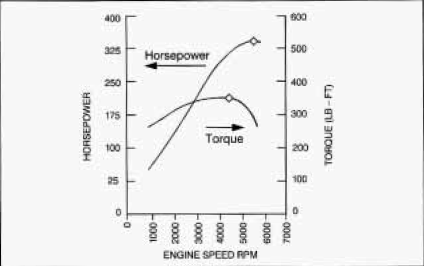
Accessory Belt Routing
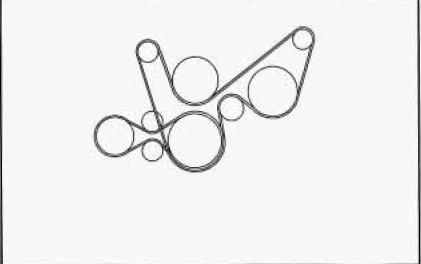
Air Conditioning Refrigerants
Not all air conditioning refrigerants are the same. If the air conditioning
system in your vehicle needs refrigerant, be sure the proper refrigerant is
used. If you're not sure, ask your dealer.